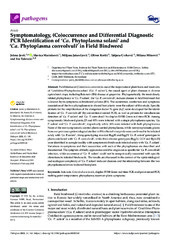Приказ основних података о документу
Symptomatology, (Co)occurrence and Differential Diagnostic PCR Identification of ‘Ca. Phytoplasma solani’ and ‘Ca. Phytoplasma convolvuli’ in Field Bindweed
| dc.creator | Jovic, Jelena | |
| dc.creator | Marinković, Slavica | |
| dc.creator | Jakovljević, Miljana | |
| dc.creator | Krstić, Oliver | |
| dc.creator | Cvrković, Tatjana | |
| dc.creator | Mitrović, Milana | |
| dc.date.accessioned | 2023-07-13T10:30:38Z | |
| dc.date.available | 2023-07-13T10:30:38Z | |
| dc.date.issued | 2021 | |
| dc.identifier.issn | 2076-0817 | |
| dc.identifier.uri | https://plantarum.izbis.bg.ac.rs/handle/123456789/693 | |
| dc.description.abstract | Field bindweed (Convolvulus arvensis) is one of the major natural plant hosts and reservoirs of ‘Candidatus Phytoplasma solani’ (‘Ca. P. solani’), the causal agent of plant diseases in diverse agricultural crops, including Bois noir (BN) disease of grapevine. Phylogenetically, the most closely related phytoplasma to ‘Ca. P. solani’, the ‘Ca. P. convolvuli’, induces disease in field bindweed that is known by its symptoms as bindweed yellows (BY). The occurrence, coinfection and symptoms association of the two phytoplasmas in shared host plants were the subject of this study. Specific primers for the amplification of the elongation factor Tu gene (tuf ) were developed for the identification of ‘Ca. P. convolvuli’ (by conventional nested PCR), as well as primers for simultaneous detection of ‘Ca. P. solani’ and ‘Ca. P. convolvuli’ by duplex SYBR Green real-time PCR. Among symptomatic bindweed plants, 25 and 41% were infected with a single phytoplasma species, ‘Ca. P. solani’ and ‘Ca. P. convolvuli’, respectively, while 34% were infected with both phytoplasmas. None of the non-symptomatic control plants carried phytoplasma, while non-symptomatic plants from our previous epidemiological studies in BN-affected vineyards were confirmed to be infected solely with ‘Ca. P. solani’. Stamp gene typing revealed Rqg50 and Rqg31 ‘Ca. P. solani’ genotypes in plants coinfected with ‘Ca. P. convolvuli’, while three diverse genotypes (Rqg50, GGY and Rpm35) were identified in a single locality with symptomatic bindweeds infected solely with ‘Ca. P. solani’. Variations in symptoms and their association with each of the phytoplasmas are described and documented. The symptom of bushy appearance could be single out as specific for ‘Ca. P. convolvuli’ infection, while occurrence of ‘Ca. P. solani’ could not be unequivocally associated with specific alterations in infected bindweeds. The results are discussed in the context of the epidemiological and ecological complexity of ‘Ca. P. solani’-induced diseases and the relationship between the two phytoplasma relatives in shared host plant. | sr |
| dc.language.iso | en | sr |
| dc.publisher | MDPI Basel | sr |
| dc.relation | info:eu-repo/grantAgreement/MESTD/inst-2020/200010/RS// | sr |
| dc.relation | info:eu-repo/grantAgreement/ScienceFundRS/Promis/6060914/RS// | sr |
| dc.rights | openAccess | sr |
| dc.rights.uri | https://creativecommons.org/licenses/by/4.0/ | |
| dc.source | Pathogens | sr |
| dc.subject | bois noir | sr |
| dc.subject | Convolvulus arvensis | sr |
| dc.subject | duplex SYBR Green real-time PCR | sr |
| dc.subject | end-point nested PCR | sr |
| dc.subject | melting point temperature | sr |
| dc.subject | phytoplasma | sr |
| dc.subject | reservoir plant | sr |
| dc.subject | symptoms | sr |
| dc.title | Symptomatology, (Co)occurrence and Differential Diagnostic PCR Identification of ‘Ca. Phytoplasma solani’ and ‘Ca. Phytoplasma convolvuli’ in Field Bindweed | sr |
| dc.type | article | sr |
| dc.rights.license | BY | sr |
| dc.citation.issue | 2 | |
| dc.citation.rank | M22 | |
| dc.citation.spage | 160 | |
| dc.citation.volume | 10 | |
| dc.type.version | publishedVersion | sr |
| dc.identifier.doi | 10.3390/pathogens10020160 | |
| dc.identifier.fulltext | http://plantarum.izbis.bg.ac.rs/bitstream/id/2845/bitstream_2845.pdf | |
| dc.identifier.pmid | 33546447 | |
| dc.identifier.scopus | 2-s2.0-85100581615 | |
| dc.identifier.wos | 000622897700001 |


